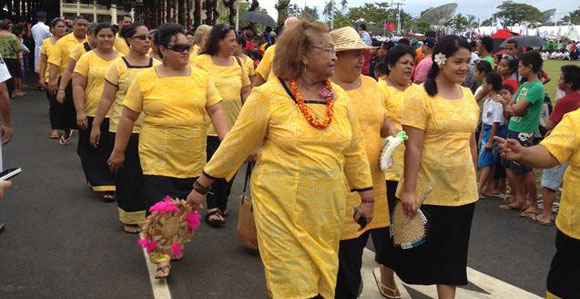Difference between revisions of "LDS Church Growth: An Apostle Visits the South Pacific"
Elya Ghent (talk | contribs) |
|||
| Line 28: | Line 28: | ||
[[Category:Mormon Life and Culture]] | [[Category:Mormon Life and Culture]] | ||
| + | |||
| + | [[ru: Рост Церкви СПД: Апостол посещает Южно-тихоокеанский округ]] | ||
Latest revision as of 10:48, 28 July 2013
The Church of Jesus Christ of Latter-day Saints, often inadvertently called the Mormon Church, counted nearly 15 million members at the end of 2012. It is a global church, but small. The Church of Jesus Christ is unique, because it has a lay clergy.
Service at every level is rendered on a volunteer basis. The Church provides a huge amount of material in many languages to support lay members in their service, which is coordinated on every level around the world. In areas where the Church is well-established, and has been for quite some time, members are experienced in church service, and know and understand how administration must be undertaken. Other areas of the world are emerging as members mature in their service and understanding of how things work in God’s kingdom on earth. Still other areas are just emerging, as new members in fledgling branches begin to serve and are instructed by missionaries and called leaders who oversee areas of the world.
An Apostle of the Lord Jesus Christ Visits the Church in the South Pacific
In April 2013 Elder Dallin H. Oaks visited the South Pacific to observe church progress and advise area leaders. His ancestors served Mormon missions in the South Pacific, so some of the Latter-day Saints he address when speaking there may have been descendants of members baptized by his great-grandfather. Within the region are found all three types of church progress. Australia and New Zealand have mature LDS congregations with experienced leadership. Samoa and Tonga display the rapidly advancing and modernizing Church of Jesus Christ. Papua New Guinea is experiencing the emerging version of the Church. The Area Presidency over the South Pacific must provide leadership that benefits all three.
Said Elder Oaks:
- “This Area Presidency has to preside over three different types of Church units. The way they use the Area Seventies and the way they administer and teach the programs of the Church have to be different in each of those three different types. That’s quite a different challenge than being in an Area Presidency in a place like Mexico where it is one nation, one culture, one language, and really one teaching method. I’ve come to appreciate in this visit the complexity of the responsibility that this Area Presidency has.” 1
Elder Oaks commented on the faithfulness of the Mormons in the area:
- “The overall impression I have as I look back on 13 days in the Pacific Area, including visits to Samoa, New Zealand, and Australia, is to reaffirm in my mind that the strength of the Church is not Church headquarters; it’s out among the people. I have seen thousands of strong Latter-day Saints keeping the commandments, making the sacrifices necessary to send sons and daughters on missions and to serve missions themselves, paying their tithing, and fulfilling the responsibilities of their Church callings.
- “The Church is strong and getting stronger in the Pacific Area. We have a distance to go, especially as we expand the message of the restored gospel into areas like Papua New Guinea or Vanuatu and Kiribati, but we are strong and getting stronger, and we are growing from our centers of strength and going forward. My attitude is profoundly optimistic about the future of the Church and its capacity to bless the Saints in the Pacific Area.” [1]
Samoa gained its independence from New Zealand on January 1, 1962. The first stake of The Church of Jesus Christ in Samoa was organized in Apia on March 18 of that year.
- Among the contributions from the Church and its members to Samoa over the last 50 years are scores of humanitarian and welfare projects. These include donations of school supplies, the construction of clean water facilities, medical and dental aid, and disaster relief. In 2011 Samoa head of state His Highness Tui Atua Tupua Tamasese visited Salt Lake City and the headquarters facilities of the Church. 2
End of 2012 statistics for the South Pacific are,
There are 496,075 Latter-day Saints in Oceania, in 15 missions and 1,159 congregations. There are 10 Mormon Temples and 278 family history centers.
